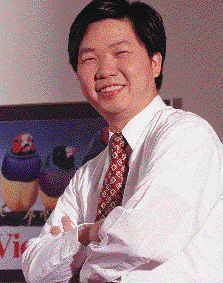|
GOLDSEA |
ASIAN AMERICAN RAGS-TO-RICHES SAGAS
THE BIRD BILLIONAIRE
PAGE 5 OF 8
Chu's removal from the politics at headquarters may have solved some problems, but it also accelerated his ultimate fall from grace.
"When we were closer I could explain," he says, "but the distance [was] longer and [there were] other people who didn't like me, so they probably said something. Things became emotional. I think somebody reported I was not organized, not solving this problem, that problem.
"[Since] I was running the operation, I needed to make lots of decisions. I needed to decide on timing, designed a lot of things. Sometimes people were suspicious because I spent money."
As part of a campaign to create an image for BTC Chu paid an ad agency $5,000 to write copy for a new ad.
"If I wrote copy, that would be a joke," Chu says. "I didn't know the culture of the U.S. Five thousand was initially high for me, but considering how much money we could make, how much profit we could make, I knew we could afford it. The decision was made. It was reported to the company. 'How can a design cost five thousand? Maybe James is getting a kickback?'"
"[There were] lots of things [I thought would be] good for the company but they thought differently," Chu recalls. "I saw the relationship was continuing to have more problem."
By late 1986 it became clear that Steel Su wanted Chu out. Despite repeated requests, Su never gave Chu a stock certificate for the 3% of BTC stock that Chu had bought. Instead, Su gave him a check for the amount of his original investment.
"It looks like the company was growing bigger," Chu recalls, "with lots of politicians, but I wasn't bigger. I wanted to continue to grow. My interests was in sales, marketing. I didn't want to be involved in the politician's game. It was not a battle I could continue to fight. It wasn't worth it."
Chu proposed to leave BTC and start his own company in Los Angeles to sell BTC keyboards in Southern California. If BTC would sell him keyboards on credit, Chu offered, he would give BTC a 40% stake in the company. Despite his desire to escape the politics, Chu had friends at BTC and wanted a hand in product development.
Su accepted. In July 1987 Chu moved to Los Angeles and opened Keypoint in Santa Fe Springs. In its first month Chu sold $1 million. Barely three months later, Su told Chu he no longer wanted to ship him keyboards.
"Overnight I lost my only product," Chu says. "The company was started already. I'd hired a person, the building was rented." Su even tried to head off the shipments of keyboards that were in transit. Fortunately, Chu's friends at BTC let some keyboards out before the embargo slammed down.
Desperate, Chu called on Spokane-based Keytronics, the company that had been his chief competitor. Keytronics was a leading keyboard manufacturer. Despite its superior quality and lower prices Chu had managed to take sales away with BTC's inferior keyboards.
"They recognized me," Chu says, a swagger creeping into his voice. "Even if you sell a high-priced product for a much lower price, it's still [seen as being of] lesser quality because you don't know your customer."
Keytronics didn't pass up the chance to get Chu on its side. It shipped keyboards on credit, protecting itself with UCC filings on everything in Chu's warehouse. Confident of his sales ability, Chu committed to take shipment of everything Keytronics produced for the next six months.
[CONTINUED BELOW]
Chu's biggest success in selling Keytronics keyboards was to mail-order companies. This was a fast-growing channel whose low-quality, low-price image kept most name brands away. Dell Computers was a mail-order company that quickly grew to be the industry's number three PC maker. In the proliferation of no-name companies vying to sell low-end products Chu spotted a demand for quality products at reasonable prices.
At that time Keypoint was little more than Chu and two employees. He attributes his quick success to his initial pinpoint focus on keyboards and on the mail order channel. That gave him the baseline success he needed to move into the monitor market in 1989.
"It was the right time for the right thing," Chu says. "I saw that the business had a lot of opportunities, we had a good customer base, lots of good channels who can buy products from us. I knew they needed a product that was high performance but low cost. Not as low as other competitors, but value at a low cost. People wanted a brand name product. If they put a monitor on their desks with no name, it's no good for the image. So they recognized a monitor with an image as a good quality piece."
Chu decided to sell monitors that had a level of quality comparable to NEC but with added features--at a price lower than big name brands but higher than other no-name clones.
PAGE 6
PAGE 1 |
2 |
3 |
4 |
5 |
6 |
7 |
8
|
|
|
|

<
|
“A lot of people think business is so complicated,
so difficult, and you need a lot of knowledge... It's not that difficult.”
|
CONTACT US
|
ADVERTISING INFO
© 1996-2013 Asian Media Group Inc
No part of the contents of this site may be reproduced without prior written permission.
|







